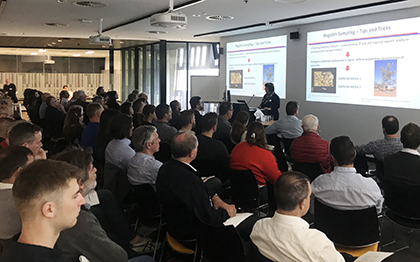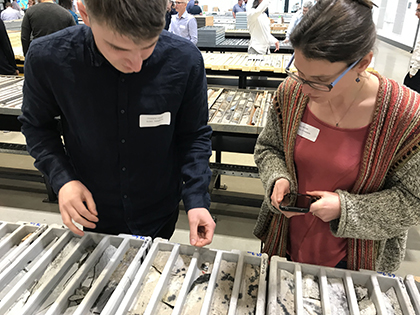Geoscience workshop reaffirms strong exploration interest.
There was a positive energy throughout the day as a full house of over 90 delegates gathered for a geoscience workshop on the central Gawler Craton region on 20 September at the South Australia Drill Core Reference Library.
The central Gawler Craton region is known for various mineral systems, exemplified by Mesoproterozoic gold deposits such as Tarcoola goldfield and Tunkillia, along with the earliest known deposit, the Archean–Paleoproterozoic Challenger Mine. This region of the Gawler Craton lies beneath relatively shallow cover with large regions of less than 50 m of cover, meaning surface geochemical surveys have the potential to provide important signals of the buried basement. For these reasons, the central Gawler Craton region remains of intense interest for mineral explorers keen to make use of the new precompetitive data across the region – in particular, the fantastic new imagery available from the Gawler Craton Airborne Survey – to understand the basement geology and mineral potential.
Hosted by the Geological Survey of South Australia (GSSA), the day comprised presentations on key themes and a regolith rock display plus core viewing session. Many lively conversations around the geoscience of this region were held over lunch and during the viewing session. An interactive discussion session at the end of the day facilitated by Carmen Krapf enabled the GSSA to receive feedback from exploration companies on current and future work programs.
Anna Petts from the GSSA presenting on surface geochemistry in the central Gawler Craton region. (Photo 417931)
The first session was dedicated to surface geology and geochemistry and included reviews by Carmen Krapf and Anna Petts of GSSA on the geology and geochemistry of the cover, and the untapped potential of legacy data. Ignacio (Nacho) González-Álvarez of CSIRO discussed his work aimed at integrating landscape evolution with surface geochemistry, both in Western Australia and as part of a new collaboration with GSSA.
A series of talks followed that looked at the basement geology through the lens of the recent Gawler Craton Airborne Survey. In particular, Clive Foss of CSIRO and Mark Pawley of GSSA discussed value adding to the survey data through new interpretations of the depth of magnetic features and of the structure and stratigraphy of the basement geology.
Of further interest were three talks on the mineral systems of the central Gawler Craton. Justin Gum of the GSSA provided an overview of the main mineral systems through time and emphasised how many of these systems have received little attention during mineral exploration campaigns of the past. Ian Gregory of Western Areas Ltd presented on the company’s work in the Fowler Domain, a region of the western Gawler Craton that is a frontier region for exploration, highlighting new rocks types discovered during the project and collaborative work with GSSA on geochronology and regional geology. Well-known South Australian exploration geologist Ken Cross gave a fantastic talk that examined the key similarities between the central and southern Gawler Range Volcanics regions with what is known of the iron oxide – copper–gold (IOCG) deposits such as Olympic Dam from the eastern Gawler Craton. Ken’s talk challenged us to broaden our concepts of where IOCG mineralisation could be found in the Gawler Craton and stimulated a lot of follow-up discussion.
The final session was dedicated to understanding the geoscientific database that GSSA holds over the region. Liliana Stoian provided a sobering account of a data audit that showed that large gaps exist in our databases as a result of people sampling core from the South Australia Drill Core Reference Library and not returning results of that sampling. This challenged many of the audience to consider the importance of returning and providing geoscientific data to the state’s databases as these exist in perpetuity to provide information for future explorers to access and interrogate. This is also important as we consider the ability of machine learning and artificial intelligence to be useful in areas of poor data density as these rely on large databases to function. Practicalities of exploration were also discussed by the department’s Rob Shaw who reviewed current exploration in the region and gave tips on how best to apply for new ground across South Australia.
The core viewing session featured around 2 km of drill core and cuttings representing key drillholes showcasing the different styles of mineralisation in the central Gawler Craton region. (Photo 417932)
Complementing the presentations was an incredible collection of physical rock specimens from the central Gawler Craton. Participants engaged with the geology of the cover sequences of the region through display of GSSA’s regolith rock collection, arranged by Carmen Krapf. Further, nearly 2 km of drill core and cuttings were on display representing key drillholes showcasing the different styles of mineralisation from Archean gold to mafic and ultramafic rocks of the Harris Greenstone Belt to Mesoproterozoic epithermal and orogenic gold systems. A report book that summarises these drill cores is in preparation and will provide an incredible resource for the future to showcase these different styles in one convenient collection.
Feedback following the workshop suggests all attendees were satisfied or very satisfied with the overall experience, giving encouragement for GSSA to continue with similar smaller workshops. They are an ideal way to showcase facets of geoscience and local geology in focus areas as well as provide forums for meaningful discussions around the key geological questions and exploration achievements and challenges.
Central Gawler Craton geoscience workshop presentations
– Anthony Reid, October 2019




